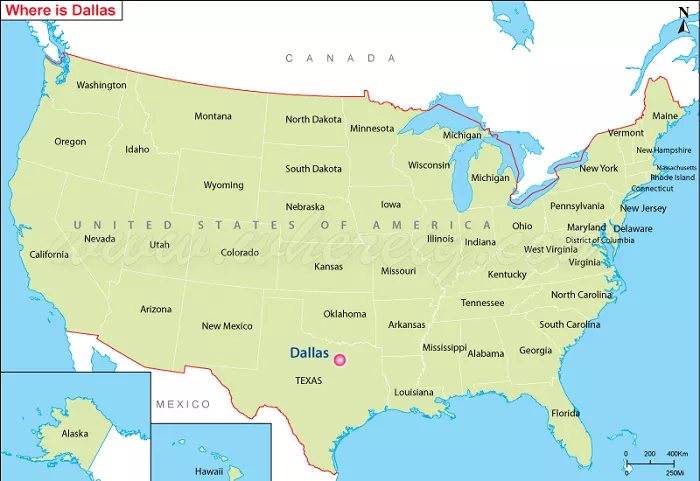Dallas is one of the largest and most important cities in the United States. It is located in the state of Texas, in the southern part of the country. Known for its modern skyline, rich history, and strong economy, Dallas attracts millions of visitors every year.
If you are wondering, “Where is Dallas, USA?”, this guide will give you a detailed answer. We will explore Dallas’s exact location, its geography, nearby cities, and why it is such a significant place in America.
Location of Dallas
Dallas is situated in the northeastern part of Texas, at the convergence of the East, West, and Clear Forks of the Trinity River. This strategic location has historically made it an important center for commerce and transportation. The city lies approximately 30 miles east of Fort Worth, another major city in the region. It is the county seat of Dallas County, with portions extending into Collin, Denton, Kaufman, and Rockwall counties.
History of Dallas
1. Early Settlement
In 1841, John Neely Bryan, a lawyer and trader from Tennessee, established a trading post along the Trinity River, marking the beginnings of Dallas. The area attracted settlers due to its fertile lands and strategic location for trade.
2. Economic Development
The arrival of railroads in the 1870s significantly boosted Dallas’s economy, making it a central hub for transporting cotton, cattle, and oil. This development positioned Dallas as a major industrial and financial center in the region.
3. 20th Century Growth
The construction of the Interstate Highway System reinforced Dallas’s prominence as a transportation hub, with four major interstate highways converging in the city and a fifth interstate loop around it. The opening of Dallas/Fort Worth International Airport in 1974 further enhanced the region’s connectivity, solidifying its status as a global transportation center.
Geography of Dallas
1. Terrain and Elevation
Dallas is located on the rolling prairies of northeast Texas, where the three branches of the Trinity River merge. The city covers an area of approximately 385 square miles, characterized by flat terrain with elevations ranging from 400 to 600 feet above sea level.
2. Climate
Dallas experiences a humid subtropical climate, with hot, humid summers and mild winters. July and August are typically the hottest months, with average high temperatures around 96°F (36°C). Winters are cool to mild, with January being the coldest month, averaging daytime highs of 56.8°F (13.8°C) and nighttime lows of 37.3°F (2.9°C).
Cultural Significance
1. Arts and Entertainment
Dallas boasts a vibrant arts scene, with numerous museums, theaters, and music venues. The Dallas Arts District is one of the largest urban arts districts in the United States, featuring institutions like the Dallas Museum of Art and the Winspear Opera House.
2. Sports
The city is home to several professional sports teams, including the Dallas Cowboys (NFL) and the Dallas Mavericks (NBA), fostering a strong sports culture among residents and visitors alike.
Economy
Dallas has a diverse economy with strengths in sectors such as defense, financial services, information technology, telecommunications, and transportation. The Dallas-Fort Worth metroplex hosts 23 Fortune 500 companies, the second-most in Texas and fourth-most in the United States, with 11 of those companies located within Dallas city limits.
Transportation
As a transportation hub, Dallas is served by multiple interstate highways and two major airports: Dallas/Fort Worth International Airport and Dallas Love Field. The city also has an extensive public transit system, including buses and light rail services operated by Dallas Area Rapid Transit (DART).
Education
Dallas is served by several school districts, with the Dallas Independent School District being the largest. The city is also home to institutions of higher learning, such as the University of Texas at Dallas and Southern Methodist University.
Attractions
Visitors to Dallas can explore a variety of attractions, including:
- The Sixth Floor Museum at Dealey Plaza: Dedicated to the life and legacy of President John F. Kennedy.
- Fair Park: A 277-acre recreational and cultural complex that hosts the annual State Fair of Texas.
- Reunion Tower: An iconic observation tower offering panoramic views of the city.
- Dallas World Aquarium: Featuring diverse marine life and ecosystems from around the world.
Conclusion
Dallas, Texas, is a dynamic city known for its rich history, cultural diversity, and economic significance. Its strategic location, robust infrastructure, and vibrant arts scene make it a noteworthy destination for both residents and visitors.

